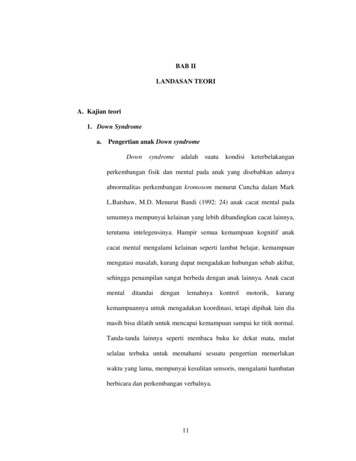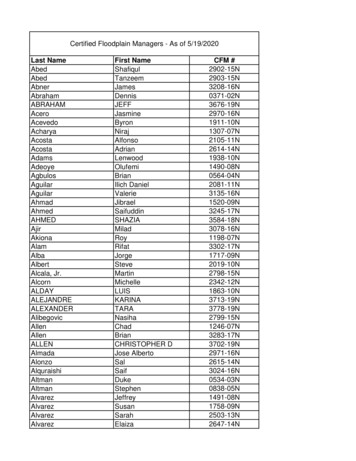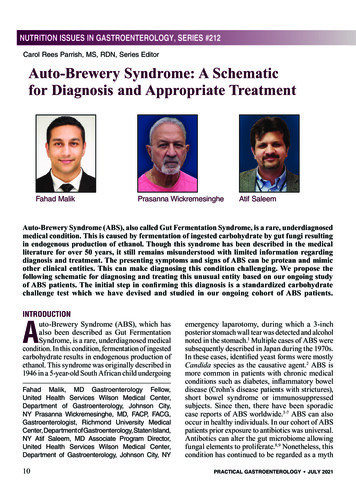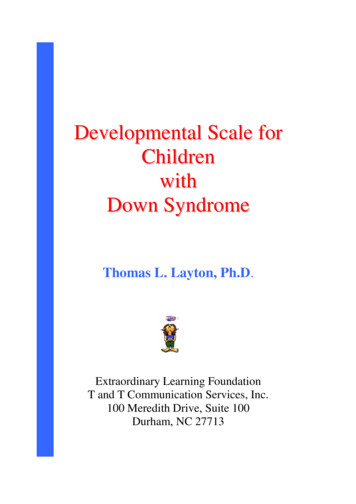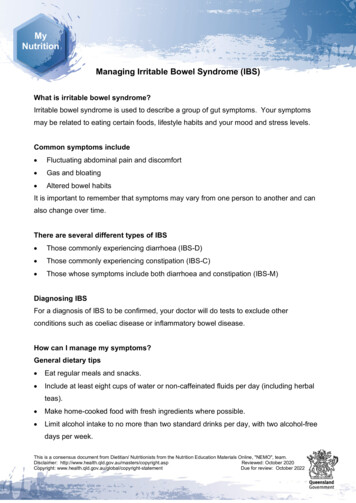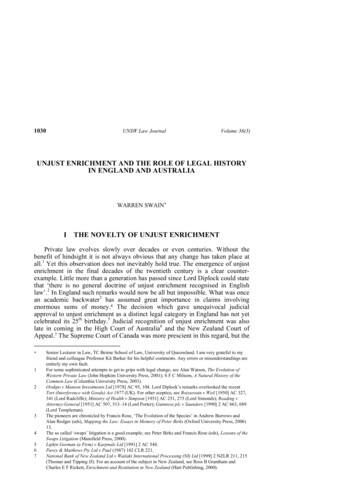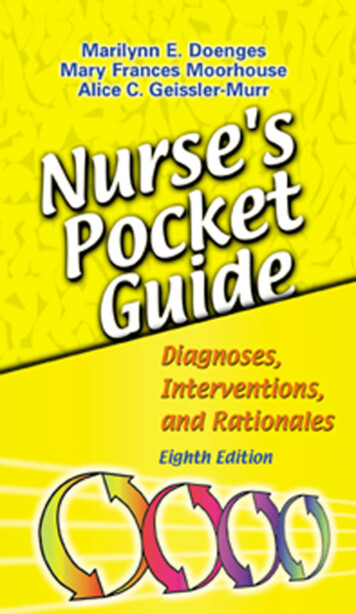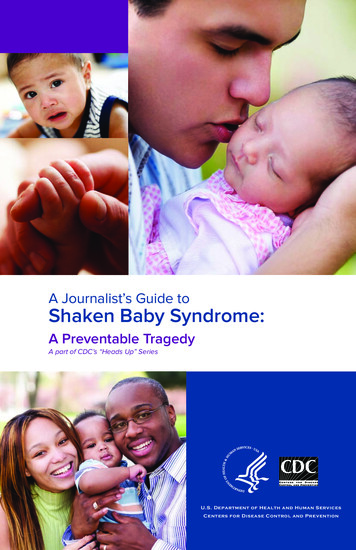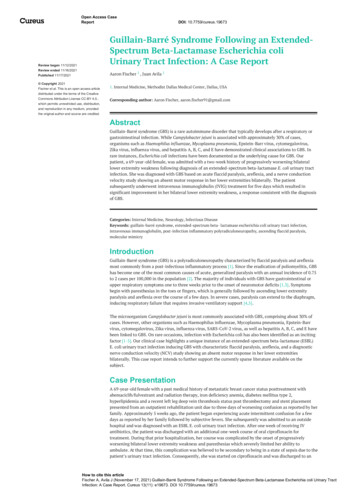
Transcription
Open Access CaseReportDOI: 10.7759/cureus.19673Guillain-Barré Syndrome Following an ExtendedSpectrum Beta-Lactamase Escherichia coliUrinary Tract Infection: A Case ReportReview began 11/12/2021Review ended 11/16/2021Aaron Fischer 1 , Juan Avila 1Published 11/17/2021 Copyright 2021Fischer et al. This is an open access article1. Internal Medicine, Methodist Dallas Medical Center, Dallas, USAdistributed under the terms of the CreativeCommons Attribution License CC-BY 4.0.,which permits unrestricted use, distribution,Corresponding author: Aaron Fischer, aaron.fischer91@gmail.comand reproduction in any medium, providedthe original author and source are credited.AbstractGuillain-Barré syndrome (GBS) is a rare autoimmune disorder that typically develops after a respiratory orgastrointestinal infection. While Campylobacter jejuni is associated with approximately 30% of cases,organisms such as Haemophilus influenzae, Mycoplasma pneumonia, Epstein-Barr virus, cytomegalovirus,Zika virus, influenza virus, and hepatitis A, B, C, and E have demonstrated clinical associations to GBS. Inrare instances, Escherichia coli infections have been documented as the underlying cause for GBS. Ourpatient, a 69-year-old female, was admitted with a two-week history of progressively worsening bilaterallower extremity weakness following diagnosis of an extended-spectrum beta-lactamase E. coli urinary tractinfection. She was diagnosed with GBS based on acute flaccid paralysis, areflexia, and a nerve conductionvelocity study showing an absent motor response in her lower extremities bilaterally. The patientsubsequently underwent intravenous immunoglobulin (IVIG) treatment for five days which resulted insignificant improvement in her bilateral lower extremity weakness, a response consistent with the diagnosisof GBS.Categories: Internal Medicine, Neurology, Infectious DiseaseKeywords: guillain-barré syndrome, extended-spectrum beta- lactamase escherichia coli urinary tract infection,intravenous immunoglobulin, post-infection inflammatory polyradiculoneuropathy, ascending flaccid paralysis,molecular mimicryIntroductionGuillain-Barré syndrome (GBS) is a polyradiculoneuropathy characterized by flaccid paralysis and areflexiamost commonly from a post-infectious inflammatory process [1]. Since the eradication of poliomyelitis, GBShas become one of the most common causes of acute, generalized paralysis with an annual incidence of 0.75to 2 cases per 100,000 in the population [2]. The majority of individuals with GBS have gastrointestinal orupper respiratory symptoms one to three weeks prior to the onset of neuromotor deficits [1,3]. Symptomsbegin with paresthesias in the toes or fingers, which is generally followed by ascending lower extremityparalysis and areflexia over the course of a few days. In severe cases, paralysis can extend to the diaphragm,inducing respiratory failure that requires invasive ventilatory support [4,5].The microorganism Campylobacter jejuni is most commonly associated with GBS, comprising about 30% ofcases. However, other organisms such as Haemophilus influenzae, Mycoplasma pneumonia, Epstein-Barrvirus, cytomegalovirus, Zika virus, influenza virus, SARS-CoV-2 virus, as well as hepatitis A, B, C, and E havebeen linked to GBS. On rare occasions, infection with Escherichia coli has also been identified as an incitingfactor [1-5]. Our clinical case highlights a unique instance of an extended-spectrum beta-lactamase (ESBL)E. coli urinary tract infection inducing GBS with characteristic flaccid paralysis, areflexia, and a diagnosticnerve conduction velocity (NCV) study showing an absent motor response in her lower extremitiesbilaterally. This case report intends to further support the currently sparse literature available on thesubject.Case PresentationA 69-year-old female with a past medical history of metastatic breast cancer status posttreatment withabemaciclib/fulvestrant and radiation therapy, iron deficiency anemia, diabetes mellitus type 2,hyperlipidemia and a recent left leg deep vein thrombosis status post thrombectomy and stent placementpresented from an outpatient rehabilitation unit due to three days of worsening confusion as reported by herfamily. Approximately 5 weeks ago, the patient began experiencing acute intermittent confusion for a fewdays as reported by her family followed by subjective fevers. She subsequently was admitted to an outsidehospital and was diagnosed with an ESBL E. coli urinary tract infection. After one week of receiving IVantibiotics, the patient was discharged with an additional one-week course of oral ciprofloxacin fortreatment. During that prior hospitalization, her course was complicated by the onset of progressivelyworsening bilateral lower extremity weakness and paresthesias which severely limited her ability toambulate. At that time, this complication was believed to be secondary to being in a state of sepsis due to thepatient’s urinary tract infection. Consequently, she was started on ciprofloxacin and was discharged to anHow to cite this articleFischer A, Avila J (November 17, 2021) Guillain-Barré Syndrome Following an Extended-Spectrum Beta-Lactamase Escherichia coli Urinary TractInfection: A Case Report. Cureus 13(11): e19673. DOI 10.7759/cureus.19673
acute rehabilitation facility; however, she experienced little to no improvement in her strength despitebeing compliant with her prescribed antibiotics.On physical examination, the patient had normal vital signs and was noted to be alert and oriented with nosigns of apparent respiratory distress. No suprapubic or costovertebral angle tenderness was elicited. Herneurologic exam demonstrated significantly decreased strength of her bilateral lower extremities withpreserved sensation to light touch grossly. The remainder of her exam was unremarkable. Pertinentadmission laboratory data included a leukocytosis of 18,300/uL with neutrophilic predominance, normocyticanemia with a hemoglobin of 8.9 mg/dL and mean corpuscular volume of 97.1 fL, hypercalcemia of 12.9mg/dL, mild hypoglycemia of 69 mg/dL, and decreased thyroid-stimulating hormone at 0.16 uIU/mL butnormal T3 and T4 levels, normal vitamin B12, vitamin B1 and folate levels, negative blood cultures and afairly normal urinalysis. Chest x-ray and computed tomography scan without contrast of the head showedno acute abnormalities. Of note, the patient had a brain magnetic resonance imaging (MRI) studyapproximately one-month prior that showed a small right frontal meningioma that appeared stable on herCT this admission. CT of the lumbar spine without contrast showed mixed lytic/sclerotic appearance of thebones suggesting metastatic disease and multilevel spondylosis without high-grade spinal canal stenosis.Given the patient's presentation of acute encephalopathy in the setting of leukocytosis and history of recentESBL E. coli UTI, there was concern that the patient was inadequately treated with ciprofloxacin. Thus, shewas given a one-time dose of Fosfomycin, along with IV fluids for her hypercalcemia, which improved hermental status and laboratory abnormalities. Work-up for the hypercalcemia was otherwise unremarkableand ultimately attributed to dehydration. Inpatient neurology and neurosurgery services were consulted foradditional assistance with the management of acute paraparesis. No neurosurgical interventions werewarranted. Additional laboratory work-up, including serum and urine protein electrophoresis, neuronalantibody (amphiphysin), CV2.1 IgG antibody and Purkinje cell/neuronal nuclear IgG antibody levels, wasunremarkable. The patient underwent further imaging with MRI of the cervical, thoracic, and lumbar spine,which showed diffuse osseous metastatic lesions but no evidence of spinal cord compression or severestenosis. A subsequent electroencephalogram demonstrated no signs of any epileptiform activity. Anelectromyography (EMG) study was obtained revealing complex polyphasic motor unit potentials in theright anterior tibialis, medial gastrocnemius, vastus lateralis, and tensor fascia lata muscles. Paraspinalmuscles were not examined due to the patient being on anticoagulation for her history of deep veinthrombosis. Sensory nerve conduction studies were obtained and shown below (Figure 1, Table 1). Motornerve conduction studies were obtained which showed no response in the lower extremity muscles or in theright radial study (Figure 2, Table 2). The patient also had poor F-wave responses on motor testing in herlower extremity muscles (Figure 3). The patient was treated with a five-day course of intravenousimmunoglobulin (IVIG) for suspected GBS. This resulted insignificant improvement in her lower extremitystrength bilaterally. At the end of her hospital course, she was discharged to a skilled nursing facility forfurther care.FIGURE 1: Sensory nerve conduction.Nerve/sitesRec sitePeak lat (ms)PP Amp (µV)SegmentsLeft sural – ankle (calf)Lower legAnkleLower leg – ankleLower legAnkleLower leg – lower legLower legAnkle7.2481.9Lower leg – lower legTABLE 1: Sensory nerve conduction.2021 Fischer et al. Cureus 13(11): e19673. DOI 10.7759/cureus.196732 of 5
FIGURE 2: Motor nerve conduction studies revealed no response in thelower extremities.AH: abductor hallucis; EDB: extensor digitorum lativeamplitude (%)Duration(ms)SegmentsDistance(mm)0.71004.95Ankle – AH400Lat Diff(ms)Right Tibial – AHAnkleAH5.00PoplitealfossaAH6.98Popliteal fossa – Ankle1.98Left Peroneal – EDBAnkleEDB16.150.3100Ankle – EDBFibularheadEDBFibular head – AnklePoplitealfossaEDBPopliteal fossa –Fibular head80TABLE 2: Motor nerve conduction studies revealed no response in the lower extremities.AH: abductor hallucis; EDB: extensor digitorum brevis.FIGURE 3: F-wave study showing the lack of reflex motor response inlower extremity muscles.AH: abductor hallucis; EDB: extensor digitorum brevis.DiscussionThis case report illustrates the development of acute paraparesis, most consistent with the diagnosis of GBS,after an ESBL E. coli urinary tract infection. Two-thirds of GBS patients have antecedent respiratory orgastrointestinal symptoms which our patient denied.2021 Fischer et al. Cureus 13(11): e19673. DOI 10.7759/cureus.196733 of 5
Following a Campylobacter infection, IgA or IgG antibodies are produced against the bacterial cell wall and,in some cases, cross-react with various epitopes of human nerve cell gangliosides [6]. The four types ofgangliosides targeted by these autoantibodies are GM1, GD1a, GT1a, and GQ1b. GBS develops as a result ofmolecular mimicry between human GM1 ganglioside and the lipooligosaccharide found on the cell wallsurface of C. jejuni. However, the majority of individuals with these autoantibodies do not develop GBS [7,8].Escherichia coli is an enteric Gram-negative rod that frequently causes urinary tract infections. E. colicontains lipopolysaccharide (LPS) on its outer capsule, as do all other gram-negative bacilli; however,studies have not demonstrated homology between E. coli LPS and the GM1 ganglioside. Documented casesof GBS patients with positive IgG antibodies to gangliosides on neurons result in low amplitudemeasurements for the compound muscle action potentials as well as normal to decreased nerve conductionvelocities [1,2]. Only a few cases of preceding E. coli urinary tract infections in GBS patients have beenobserved, with a couple presenting as recurrent GBS. Acute motor neuronal neuropathy was seen in most ofthese patients with positive antibodies to the GM1 and GD1a gangliosides [1,2].Our patient met the criteria of GBS with the clinical picture of rapidly developing paraparesis, areflexia, andnerve conduction studies showing severely reduced amplitudes with lack of motor responses in bilaterallower extremities. Given GBS is a diagnosis of exclusion, the primary attempt of our in-depth workup was toexclude all other likely diagnoses that would explain her clinical presentation. Our patient's central nervoussystem imaging and serum studies evaluating paraneoplastic etiologies were all negative. There have beenstudies showing breast cancer inducing neurological dysfunction via a paraneoplastic mechanism with thegeneration of autoantibodies such as Anti Hu, Ri, etc. However, these syndromes are generally associatedwith cerebellar dysfunction as the primary neurological issue, which our patient did not present with [9,10].Anti Ri itself has been known to not directly affect the peripheral nervous system, which was clearlyidentified in our patient’s nerve conduction studies [10]. Our patient was documented to have negativeparaneoplastic studies that included neuronal antibody (amphiphysin), CV2.1 IgG antibody and Purkinjecell/neuronal nuclear IgG antibody levels thus, making it very unlikely for her to have had a paraneoplasticsyndrome secondary to a breast cancer etiology. Other differential diagnoses can be postulated such as ourpatient having acute lower extremity sensorimotor polyneuropathy secondary to the patient's history of type2 diabetes or her past infusions of chemotherapy as explanations for her clinical presentation; however,these generally would not have had resolution of her symptoms after IVIG treatment. It could also bepossible that our patient may have had an alternative autoimmune illness from an undiagnosedparaneoplastic syndrome; however, the temporal relationship between her urinary tract infection and theonset of her neurological symptoms one to two weeks after, point towards this as the most reasonable causeand is consistent with the chronological events of GBS known in the literature [3]. The objective findingssupportive of GBS itself are the presence of her lower extremity areflexia, lower extremity weakness in thesetting of absent motor responses on nerve conduction velocity studies of her lower extremities and rightradial study as well as improvement after IVIG treatment.The two primary treatment options for GBS are plasmapheresis and (IVIG). Plasmapheresis reduces theautoimmune response against the patient’s nervous system by filtering out antibodies from the serum,whereas IVIG inhibits the autoantibodies directly. Plasmapheresis is most effective when used within fourweeks after the initiation of symptoms. IVIG has proven to be just as efficacious when started within twoweeks of symptom onset [11,12]. However, IVIG is generally used initially due to its ease of administrationand lower complication risk profile [13]. Steroids have not been shown to be beneficial and some studieshave indicated an association with longer recovery times [14]. Lastly, physical therapy has been shown to bea beneficial component in ensuring patients with GBS return to their baseline level of strength [15,16].ConclusionsThis 69-year-old female’s acute flaccid paralysis, areflexia, and her absent motor response on nerveconduction velocity studies after the onset of an ESBL E. coli urinary tract infection points towards this asthe most likely etiology of her GBS. The resolution of our patient’s neuropathy with five days of IVIGtreatment indicates further evidence of the diagnosis of GBS itself and illustrates a reasonable treatmentoption for future patients who develop this complication of an ESBL E. coli urinary tract infection.Additional InformationDisclosuresHuman subjects: Consent was obtained or waived by all participants in this study. Conflicts of interest: Incompliance with the ICMJE uniform disclosure form, all authors declare the following: Payment/servicesinfo: All authors have declared that no financial support was received from any organization for thesubmitted work. Financial relationships: All authors have declared that they have no financialrelationships at present or within the previous three years with any organizations that might have aninterest in the submitted work. Other relationships: All authors have declared that there are no otherrelationships or activities that could appear to have influenced the submitted work.References2021 Fischer et al. Cureus 13(11): e19673. DOI 10.7759/cureus.196734 of 5
1.2.3.4.5.6.7.8.9.10.11.12.13.14.15.16.Kono Y, Nishitarumizu K, Higashi T, Funakoshi K, Odaka M: Rapidly progressive Guillain-Barré syndromefollowing Escherichia coli infection. Intern Med. 2007, 46:589-91. 10.2169/internalmedicine.46.6330Jo YS, Choi JY, Chung H, Kim Y, Na SJ: Recurrent Guillain-Barré syndrome following urinary tract infectionby Escherichia coli. J Korean Med Sci. 2018, 33:e29. 10.3346/jkms.2018.33.e29Guillain-Barré Syndrome Fact Sheet. (2021). Accessed: %C3%A9Syndrome-Fact-Sheet.Ropper AH: The Guillain-Barré syndrome. N Engl J Med. 1992, 326:1130-6. 10.1056/NEJM199204233261706Dimachkie MM, Barohn RJ: Guillain-Barré syndrome and variants. Neurol Clin. 2013, 31:491-510.10.1016/j.ncl.2013.01.005Willison HJ, Goodyear CS: Glycolipid antigens and autoantibodies in autoimmune neuropathies . TrendsImmunol. 2013, 34:453-9. 10.1016/j.it.2013.05.001Yuki N, Hartung HP: Guillain-Barré syndrome. N Engl J Med. 2012, 366:2294-304. 10.1056/NEJMra1114525Kuwabara S, Yuki N: Axonal Guillain-Barré syndrome: concepts and controversies . Lancet Neurol. 2013,12:1180-8. 10.1016/S1474-4422(13)70215-1Paraneoplastic Antibodies (Hu, Yo, Ri). (2011). Accessed: neoplastic-antibodies-hu-yo-ri.html?category id 15. Paraneoplastic Antibodies (anti-Hu,Yo, Ri, Ma). Accessed: -ri-ma/.Hughes RA, Swan AV, van Doorn PA: Intravenous immunoglobulin for Guillain-Barré syndrome . CochraneDatabase Syst Rev. 2014, CD002063. 10.1002/14651858.CD002063.pub6Khan F, Amatya B: Rehabilitation interventions in patients with acute demyelinating inflammatorypolyneuropathy: a systematic review. Eur J Phys Rehab Med. 2012, 48: 507-22.Hughes RA, Wijdicks EF, Barohn R, et al.: Practice parameter: immunotherapy for Guillain-Barré syndrome:report of the Quality Standards Subcommittee of the American Academy of Neurology. Neurology. 2003,61:736-40. 10.1212/wnl.61.6.736Dantal J: Intravenous immunoglobulins: in-depth review of excipients and acute kidney injury risk . Am JNephrol. 2013, 38:275-84. 10.1159/000354893Hughes RA, Swan AV, van Koningsveld R, van Doorn PA: Corticosteroids for Guillain-Barré syndrome.Cochrane Database Syst Rev. 2006, CD001446. 10.1002/14651858.CD001446.pub2Khan F, Ng L, Amatya B, Brand C, Turner-Stokes L: Multidisciplinary care for Guillain-Barré syndrome. TheCochrane Database of Syst Rev. 2010, 10:CD008505. 1002/14651858.CD008505.pub22021 Fischer et al. Cureus 13(11): e19673. DOI 10.7759/cureus.196735 of 5
No neurosurgical interventions were warranted. Additional laboratory work-up, including serum and urine protein electrophoresis, neuronal antibody (amphiphysin), CV2.1 IgG antibody and Purkinje cell/neuronal nuclear IgG antibody levels, was unremarkable. The patient underwent further imaging with MRI of the cervical, thoracic, and lumbar spine,
